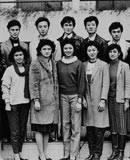不支持Flash
|
同等学力考研英语备考资料之阅读理解(二)
Passage 4
Material culture refers to what can be seen, held, felt, used--what a culture produces. Examining a culture’s tools and technology can tell us about the group’s history and way of life. Similarly, research into the material culture of music can help us to understand the music culture. The most vivid body of material culture in it, of course, is musical instruments. We cannot hear for ourselves the actual sound of any musical performance before the 1870s when the phonograph was invented, so we rely on instruments for important information about music cultures in the remote past and their development. Here we have two kinds of evidence: instruments well preserved and instruments pictured in art. Through the study of instruments, as well as paintings, written documents, and so on, we can explore the movement of music from the Near East to China over a thousand years ago, or we can outline the spread of Near Eastern influence to Europe that resulted in the development of most of the instruments in the symphony orchestra.
Sheet music or printed music, too, is material culture. Scholars once defined folk music cultures as those in which people learn and sing music by ear rather than from print, but research shows mutual influence among oral and written sources during the past few centuries in Europe, Britain, and America. Printed versions limit variety because they tend to standardize any song, yet they stimulate people to create new and different songs. Besides, the ability to read music notation has a far-reaching effect on music and, when it becomes widespread, on the music culture as a whole.
One more important part of music’s material culture should be singled out: the influence of the electronic media--radio, record player, tape recorder, television, and videocassette, with the future promising talking and singing computers and other developments. This is all part of the "information revolution", a twentieth-century phenomenon as important as the industrial revolution was in the nineteenth. These electronic media are not just limited to modem nations; they have affected music cultures all over the globe.
6. Research into the material culture of a nation is of great importance because __
A. it helps produce new cultural tools and technology
B. it can reflect the development of the nation
C. it helps understand the nation’s past and present
D. it can demonstrate the nation’s civilization
7. It can be learned from this passage that _____
A. the existence of the symphony was attributed to the spread of Near Eastern and Chinese music
B. Near Eastern music had an influence on the development of the instruments in the symphony Orchestra
C. the development of the symphony shows the mutual influence of Eastern and Western music
D. the musical instruments in the symphony orchestra were developed on the basis of Near Eastern music
8. According to the author, music notation is important because ___
A. it has a great effect on the music culture as more and more people are able to read it
B. it tends to standardize folk songs when it is used by folk musicians
C. it is the printed version of standardized folk music
D. it encourages people to popularize printed versions of songs
9. It can be concluded from the passage that the introduction of electronic media into the world of music __
A. has brought about an information revolution
B. has speeded up the appearance of a new generation of computers
C. has given rise to new forms of music culture
D. has led to the transformation of traditional musical instruments
10. Which of the following best summarizes the main idea of the passage?
A. Musical instruments developed through the years will sooner or later be replaced by computers.
B. Music cannot be passed on to future generations unless it is recorded.
C. Folk songs cannot be spread far unless they are printed on music sheets.
D. The development of music culture is highly dependent on its material aspect.
特别说明:由于各方面情况的不断调整与变化,新浪网所提供的所有考试信息仅供参考,敬请考生以权威部门公布的正式信息为准。




